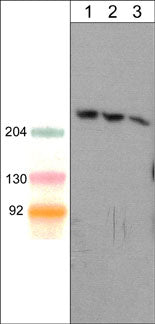Anti-Shank1 (C-terminal region) Antibody
- SPECIFICATION
- CITATIONS
- PROTOCOLS
- BACKGROUND

| Primary Accession | Q9WV48 |
|---|---|
| Reactivity | Bovine |
| Host | Mouse |
| Clonality | Mouse Monoclonal |
| Isotype | IgG1 |
| Clone Names | M369 |
| Calculated MW | 226335 Da |
| Gene ID | 78957 |
|---|---|
| Other Names | Spank1; Sstrip; Shank1a; Shank1; ProSAP |
| Storage | Maintain refrigerated at 2-8°C for up to 6 months. For long term storage store at -20°C in small aliquots to prevent freeze-thaw cycles. |
| Precautions | Anti-Shank1 (C-terminal region) Antibody is for research use only and not for use in diagnostic or therapeutic procedures. |
| Shipping | Blue Ice |

Thousands of laboratories across the world have published research that depended on the performance of antibodies from Abcepta to advance their research. Check out links to articles that cite our products in major peer-reviewed journals, organized by research category.
info@abcepta.com, and receive a free "I Love Antibodies" mug.
Provided below are standard protocols that you may find useful for product applications.
Background
A variety of anchoring and scaffold proteins that are associated with postsynaptic density (PSD) proteins have been discovered. In particular, PSD-95, GRIP, and Homer have been reported to be anchoring proteins for NMDA, AMPA, and metabotropic glutamate receptors. Shank1 is a synaptic protein that may bridge the NMDA receptor complex and the mGluR receptor complex. The Shank family includes Shank1, Shank2 (ProSAP1), and Shank3 (ProSAP2). These proteins contain several domains involved in protein-protein interactions. These include ankyrin repeats, an SH3 domain, a PDZ domain, a SAM domain, and a proline-rich region. The PDZ domain of Shank directly interacts with the C-terminal region of GKAP, which can bind to the GK domain of PSD-95 family members. The proline-rich region of Shank directly interacts with the EVH1 domain of Homer. Shank1 knock-out mice have altered PSD protein composition, reduced size of dendritic spines, and smaller PSDs. In addition, these mice have weaker basal synaptic transmission and show increased anxiety-related behavior.
If you have used an Abcepta product and would like to share how it has performed, please click on the "Submit Review" button and provide the requested information. Our staff will examine and post your review and contact you if needed.
If you have any additional inquiries please email technical services at tech@abcepta.com.













 Foundational characteristics of cancer include proliferation, angiogenesis, migration, evasion of apoptosis, and cellular immortality. Find key markers for these cellular processes and antibodies to detect them.
Foundational characteristics of cancer include proliferation, angiogenesis, migration, evasion of apoptosis, and cellular immortality. Find key markers for these cellular processes and antibodies to detect them. The SUMOplot™ Analysis Program predicts and scores sumoylation sites in your protein. SUMOylation is a post-translational modification involved in various cellular processes, such as nuclear-cytosolic transport, transcriptional regulation, apoptosis, protein stability, response to stress, and progression through the cell cycle.
The SUMOplot™ Analysis Program predicts and scores sumoylation sites in your protein. SUMOylation is a post-translational modification involved in various cellular processes, such as nuclear-cytosolic transport, transcriptional regulation, apoptosis, protein stability, response to stress, and progression through the cell cycle. The Autophagy Receptor Motif Plotter predicts and scores autophagy receptor binding sites in your protein. Identifying proteins connected to this pathway is critical to understanding the role of autophagy in physiological as well as pathological processes such as development, differentiation, neurodegenerative diseases, stress, infection, and cancer.
The Autophagy Receptor Motif Plotter predicts and scores autophagy receptor binding sites in your protein. Identifying proteins connected to this pathway is critical to understanding the role of autophagy in physiological as well as pathological processes such as development, differentiation, neurodegenerative diseases, stress, infection, and cancer.


